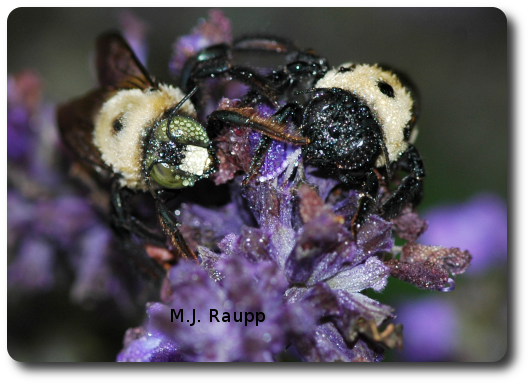During the waning days of autumn, a curious event occurs each evening in my garden where a dozen or more carpenter bees take up residence on a large herbaceous perennial called sage, also known as salvia. In the warmth of day, my sage hums with a multitude of bees, wasps, and flies. Industrious bumble bee workers return to their nest at dusk with the final loads of nectar and pollen to fatten-up any developing queens that might still be developing in the nest. Newly emerged bumble bee queens and royal wasps consume nectar and pollen to build reserves in preparation for hibernation during the barren winter season. Honey bees continue to gather nectar and pollen by day to provision the hive for winter. But with the approach of nightfall, only the large carpenter bee, Xylocopa virginica, remains behind on the blossoms to snooze.
This large sage plant serves as a nocturnal roost for many carpenter bees.
Carpenter bees are important native pollinators of many crops, but unlike bumble bees or the honey bee, the carpenter bee does not have a caste system of fertile queens and sterile workers. Each female carpenter bee can produce young. Galleries excavated in wood earlier in the year served as brood chambers for the immature carpenter bees. Bees now foraging are the shiny new adults of the brood that developed in the galleries during summer. Galleries used as nurseries earlier in the summer now serve as hibernal refuges during the cold months of winter. The object of this curiosity, the fragrant sage plant is a member of the mint family and mints are renowned for their ability to attract a variety of pollinating insects. Members of the sage family are also known for their medicinal qualities. Perhaps, the lazy behavior of my carpenter bees is related not only to the nighttime chill that cools their bodies, but also to some soporific chemical found in the nectar of sage. When the killing frosts finally put an end to my blooming sage, the last of the lazy carpenter bees will enter the brood galleries not to return until next spring.
References:
For more information on carpenter bees, please visit the following web sites.
http://www.ca.uky.edu/entomology/entfacts/ef611.asp
http://creatures.ifas.ufl.edu/misc/bees/xylocopa.htm
http://ohioline.osu.edu/hyg-fact/2000/2074.html

